Wild About Texas – May, 2009
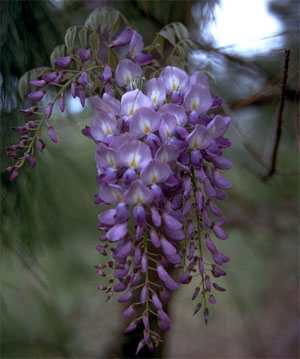
Texas wisteria.
Photo by Campbell and Lynn Loughmiller.
Texas Vines
Looking for a versatile, malleable and colorful plant for your garden? There may just be a vine to fit the bill. You can shade your house or patio with a trellis or arbor, gain privacy, hide unsightly features in the landscape, and fit foliage into narrow spaces that may not accommodate trees or shrubs. A number of species are evergreen, and some are very colorful, drawing hummingbirds and butterflies.
Try any or all of these hardy Texas natives. Some are large, so give them ample space and support:
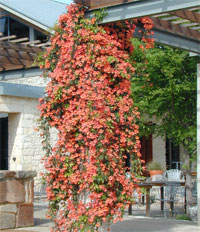
Crossvine. Photo by Joe Marcus.

Carolina jessamine. Photo by Sally and Andy Wasowski.
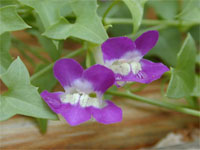
Snapdragon vine.
Photo by Joe Marcus.
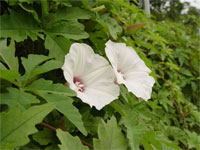
Alamo vine.
Photo by Melody Lytle.
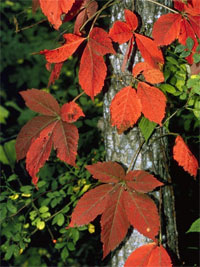
Virginia creeper.
Photo by George H. Bruso.
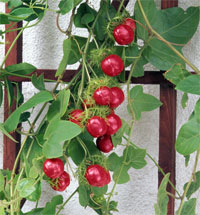
Corona de Cristo passionvine. Photo by Sally and Andy Wasowski.
Crossvine (Bignonia capreolata) — A robust evergreen reaching 50 ft. high or more, with orange, red and yellow blossoms, mostly in spring, nearly hiding all the foliage. It is native to the eastern parts of the state, but does well throughout in rich soils with moderate moisture. Great for attracting hummingbirds. Full sun to part shade.
Trumpet creeper, trumpet vine (Campsis radicans) — Related to and often confused with crossvine, trumpet creeper is a vigorous climber with tubular-shaped orange to red flowers. Differing from crossvine by being deciduous and blooming steadily throughout the summer, it also appeals to hummingbirds and large butterflies. Beware of aerial rootlets that can damage structures, and suckers that can invade your garden. Locate plants with these qualities in mind. Blooms best in full sun, but grows well in shade, too.
Carolina jessamine (Gelsemium sempervirens) –Sweetly perfumed lemon-yellow flowers appear as early as January in some years and continue throughout the spring. Frequently visited by large butterflies and sphinx moths. Evergreen throughout most of the state. Full sun to part shade.
Coral honeysuckle (Lonicera sempervirens) — A semi-evergreen, well-mannered twining vine that blooms spring through fall, and sometimes even in winter, with clusters of red trumpets that beckon large butterflies and hummingbirds. Fortunately, it is not invasive like the Japanese honeysuckle and, unfortunately, it isn’t fragrant (but well worth it anyway!). Full sun to part shade.
Snapdragon vine (Maurandella antirrhiniflora) — Cute purple flowers are like individual snapdragons from spring to frost. Foliage freezes but quickly regains ground in spring. In colder parts of Texas, it acts as a readily reseeding annual. Can be used trailing down a stone wall or as a 6- to 8-foot-tall climber. Good for covering brush piles or small trellises and will not choke out large trees. More good news: it is relatively deer resistant! Shade, part shade, full sun.
Alamo vine (Merremia dissecta) — A member of the morning glory family, this vine blossoms in white funnels with scarlet throats that open in the morning and close by afternoon, blooming late spring through fall. Deciduous foliage and “ballerina” seed pods are intricate and ornamental. Full sun to part shade.
Virginia creeper (Parthenocissus quinquefolia) — Lush and tropical looking leaves turn from green to orange and crimson in fall, especially when growing in a sunny location. This member of the grape family produces inedible clusters of fruit. Full sun to heavy shade.
Passionvines (Passiflora incarnata, P. lutea, P. foetida, others) — The most readily available native passionvine is the maypop (P. incarnata). It has very showy purple flowers but can be pesky with persistently suckering stems. All passionvines sucker, and the more delicate species such as yellow passionvine (P. lutea) are easier to manage but harder to find. Corona de Cristo (P. foetida) has intriguing tentacle-like bracts that envelope the bright red fruit. The genus, Passiflora, provides food for the caterpillars of Gulf fritillary butterflies. Full sun to considerable shade.
Grape (Vitis spp.) — Several species of native grapes can be easily grown on sturdy arbors to produce romantic fruit clusters of varying culinary appeal. The skin of mustang grapes (V. mustangensis) is irritating to some. The grapes are best processed into juices or jellies and make a good wine. Full sun to part shade.
Texas wisteria (Wisteria frutescens) — Our native wisteria is similar to the Asian species but is not aggressive or invasive. It blooms after leafing out in early- to mid-spring, and has richer colored leaves. The voluptuous, draping flower clusters have a heady fragrance. Full sun to part shade.
For more information about Texas native plants, visit the Wildflower Center’s website at: www.wildflower.org.
About the author: Andrea DeLong-Amaya is the director of horticulture at the Lady Bird Johnson Wildflower Center in Austin.
